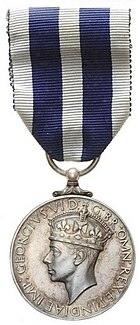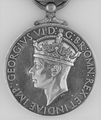
The Distinguished Flying Cross (DFC) is the third-level military decoration awarded to officers, and since 1993 to other ranks, of the United Kingdom's Royal Air Force and other services, and formerly to officers of other Commonwealth countries, for "an act or acts of valour, courage or devotion to duty whilst flying in active operations against the enemy".

The Most Excellent Order of the British Empire is a British order of chivalry, rewarding contributions to the arts and sciences, work with charitable and welfare organisations, and public service outside the civil service. It was established on 4 June 1917 by King George V and comprises five classes across both civil and military divisions, the most senior two of which make the recipient either a knight if male or dame if female. There is also the related British Empire Medal, whose recipients are affiliated with, but not members of the order.
The George Cross (GC) is the highest award bestowed by the British government for non-operational gallantry or gallantry not in the presence of an enemy. In the British honours system, the George Cross, since its introduction in 1940, has been equal in stature to the Victoria Cross, the highest military gallantry award. It is awarded "for acts of the greatest heroism or for most conspicuous courage in circumstance of extreme danger", not in the presence of the enemy, to members of the British armed forces and to British civilians. Posthumous awards have been allowed since it was instituted. It was previously awarded to residents of Commonwealth countries, most of which have since established their own honours systems and no longer recommend British honours. It may be awarded to a person of any military rank in any service and to civilians including police, emergency services and merchant seamen. Many of the awards have been personally presented by the British monarch to recipients or, in the case of posthumous awards, to next of kin. The investitures are usually held at Buckingham Palace.

The Distinguished Service Order (DSO) is a military decoration of the United Kingdom, as well as formerly of other parts of the Commonwealth, awarded for meritorious or distinguished service by officers of the armed forces during wartime, typically in actual combat. Since 1993 it has been awarded specifically for 'highly successful command and leadership during active operations', with all ranks being eligible.

The George Medal (GM), instituted on 24 September 1940 by King George VI, is a decoration of the United Kingdom and Commonwealth, awarded for gallantry "not in the face of the enemy" where the services were not so outstanding as to merit the George Cross.

The Distinguished Service Cross (DSC) is a third-level military decoration awarded to officers; and, since 1993, ratings and other ranks of the British Armed Forces, Royal Fleet Auxiliary and the British Merchant Navy have been included. Additionally, the award was formerly awarded to members of other Commonwealth countries.

The Distinguished Service Medal (DSM) was a military decoration awarded until 1993 to personnel of the Royal Navy and members of the other services, and formerly to personnel of other Commonwealth countries, up to and including the rank of Chief Petty Officer, for bravery and resourcefulness on active service at sea.

The Air Force Cross (AFC) is a military decoration awarded to officers, and since 1993 other ranks, of the United Kingdom Armed Forces, and formerly also to officers of the other Commonwealth countries. It is granted for "an act or acts of exemplary gallantry while flying, though not in active operations against the enemy". A bar is added to the ribbon for holders who are awarded a further AFC.

The Military Medal (MM) was a military decoration awarded to personnel of the British Army and other arms of the armed forces, and to personnel of other Commonwealth countries, below commissioned rank, for bravery in battle on land. The award was established in 1916, with retrospective application to 1914, and was awarded to other ranks for "acts of gallantry and devotion to duty under fire". The award was discontinued in 1993, when it was replaced by the Military Cross, which was extended to all ranks, while other Commonwealth nations instituted their own award systems in the post war period.

The Air Force Medal (AFM) was a military decoration, awarded to personnel of the Royal Air Force and other British Armed Forces, and formerly to personnel of other Commonwealth countries, below commissioned rank, for "an act or acts of valour, courage or devotion to duty whilst flying, though not in active operations against the enemy". The award was discontinued in 1993 when all ranks became eligible for the Air Force Cross (AFC) as part of the reform of the British honours system.

The Distinguished Flying Medal (DFM) was a military decoration awarded to personnel of the Royal Air Force and other British Armed Forces, and formerly to personnel of other Commonwealth countries, below commissioned rank, for "exceptional valour, courage or devotion to duty whilst flying in active operations against the enemy". The award was discontinued in 1993 when all ranks became eligible for the Distinguished Flying Cross (DFC) as part of the reform of the British honours system.

The Conspicuous Gallantry Medal (CGM) was, until 1993, a British military decoration for gallantry in action for petty officers and seamen of the Royal Navy, including Warrant Officers and other ranks of the Royal Marines. It was formerly awarded to personnel of other Commonwealth countries. In 1943 a Royal Air Force version was created for conspicuous gallantry in action against the enemy in the air.

The British Empire Medal (BEM) is a British and Commonwealth award for meritorious civil or military service worthy of recognition by the Crown. The current honour was created in 1922 to replace the original medal, which had been established in 1917 as part of the Order of the British Empire.

The King's Gallantry Medal (KGM) is a United Kingdom decoration awarded for exemplary acts of bravery where the services were not so outstanding as to merit the George Medal, but above the level required for the King's Commendation for Bravery.
The Governor-General of Australia has, at irregular intervals, notified for general information the positioning of the wearing of Australian Orders, Decorations and Medals in the Commonwealth of Australia Gazette. The Order of Wearing Australian Honours and Awards was last published in 2007, and replaced the previous list published in 2002.
The King’s Fire Service Medal, introduced in 1954, is awarded to members of the fire services in the United Kingdom for distinguished service or gallantry. It was also formerly awarded by Commonwealth countries, most of which now have their own honours systems.
The Overseas Territories Police Medal (OTPM), known as the Colonial Police Medal (CPM) until April 2012, is a medal awarded for gallantry or distinguished service to all ranks of police forces and organised fire brigades in British Overseas Territories, and formerly in Crown Colonies and British Dependent Territories. Police officers in these areas can also be awarded the higher ranking King's Police Medal. The CPM was first awarded in 1938.
The Order of Wearing of Australian honours includes Imperial honours if they were awarded prior to 6 October 1992. Imperial honours awarded after 5 October 1992 are considered foreign.
The President's Police Medal is a decoration awarded to members of law enforcement in India. Established on 1 March 1951, the medal was originally called the President's Police and Fire Service Medal. The medal is awarded for either gallantry or distinguished service, with the gallantry version of the medal being accorded a higher precedence. The medal is awarded annually on Republic Day and Independence Day.

In 1895, Queen Victoria authorised Colonial governments to adopt various British military decorations and medals and to award them to their local military forces. The Colony of Natal introduced this system in August 1895 and, in 1897, instituted the Distinguished Conduct Medal (Natal), post-nominal letters DCM.





















